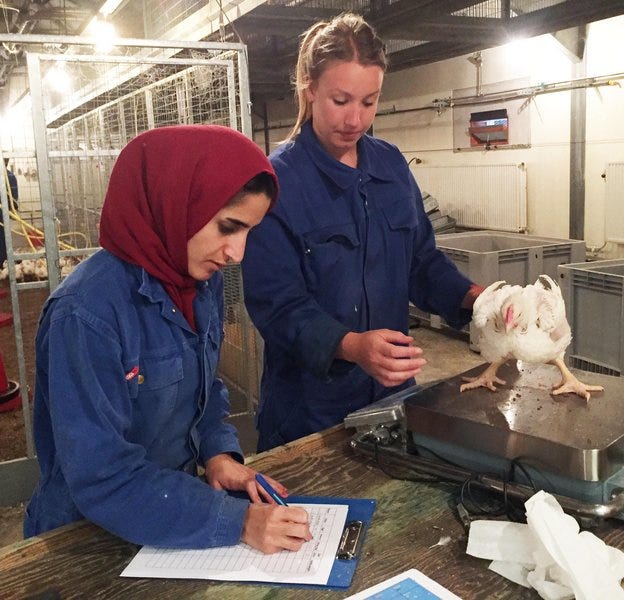Research focuses on gait problems in broilers
Aarhus researchers among first to focus on causes and effects of impaired walking ability in conventional broilers where lameness is ruled out.
May 25, 2018

What is the reason that some conventional broilers have an impaired walking ability, and does it affect their health and welfare? The Danish Veterinary & Food Administration has asked researchers from Aarhus University in Denmark to explore this question with the goal of optimizing broiler welfare.
A considerable proportion of broilers have impaired walking abilities, and many broilers walk poorly without actually being lame, the university said. The poultry industry and researchers have focused on broiler walking ability for a long time in order to monitor development and take action when necessary.

Aarhus University doctoral student Atefeh Berenjian (left) and bachelor student Maud van der Brand weigh broilers as part of a study of broiler walking ability. In the background broiler gait traits are being evaluated.
Gait is quantified
According to Aarhus, the internationally applied Bristol gait-scoring scale was developed to quantify broilers’ ability to walk. The scale goes from zero to five, with a gait score (GS) of zero meaning that a broiler has a completely normal gait, while GS5 means the bird cannot walk. Until now, most attention has been paid to broilers with GS3 or more, i.e., boilers that are at least noticeably lame, with their ability to maneuver and accelerate affected.
A 2011 survey of walking ability among broilers in Denmark showed that the proportion of broilers with GS2 was 83% — an increase from 34% in 2004-05. The latest study from 2016-17, however, showed that the proportion of GS2 broilers was reduced but still high (31%), Aarhus said. Broilers with GS2 have a definite and identifiable defect in their gait, but it does not hinder them from moving or competing for resources. It is this group of broilers that the researchers are presently investigating.
"Knowledge about the causes of GS2 and how it may affect the health and welfare of broilers is lacking. Considering the proportion of broilers in Denmark and abroad with GS2, it is important to generate knowledge about the issue," said senior researcher Anja Brinch Riber from the Aarhus department of animal science.
What does impaired walking ability mean to the broiler?
To generate more knowledge about possible correlations between GS2 and, for example, leg health, pain and body conformation, GS2 broilers are being compared with broilers with a normal gait (GS0).
"The aim is to identify factors that are important for the occurrence of GS2 in broilers," Riber explained.
The study includes 192 experimental broilers. The intensive data collection period lasts from when the broilers are approximately 27 days old to 38 days. Half of the experimental broilers have GS2, while the other half are GS0 (normal gait).
During the first two days of the trials, the broilers will be monitored by video to study their undisturbed behavior, body postures and their activity level. One day, they will be administered an analgesic. After these first two days, the broilers will go through several tests.
The first test is a runway with obstacles. This consists of a starting box, an area with obstacles and a goal area made more attractive by the presence of other broilers and mealworms. The aim of this test is to investigate if broilers with an impaired walking ability spend more time reaching the goal area than broilers with a normal gait. Half of the experimental broilers will be administered an analgesic before the test.
After the runway test, the broilers will be subjected to a conditioned place preference test. This test is used to evaluate emotional states such as pain in animals. For the first time, this test has been adapted for use in broilers, and the researchers will investigate if broilers with an impaired walking ability experience a positive emotional state when they are treated with an analgesic.
"We hope we can use this test to acquire new knowledge about possible emotional states connected to GS2 — in particular if this level of gait characteristics is related to pain," Riber said.
Ultimately, the broilers will be euthanized, and a range of measurements for disease and health will be investigated, with a focus on leg abnormalities. The researchers will also investigate body conformation, in particular because a large breast seen in broilers is considered important for gait characteristics.
The study is being carried out as part of the agreement between Aarhus and the Ministry of Environment & Food of Denmark regarding policy support and in collaboration with researchers Jo Murrell from Bristol University and Dale Sandercock from Scotland’s Rural College in the U.K.
You May Also Like



